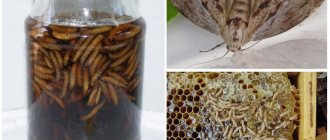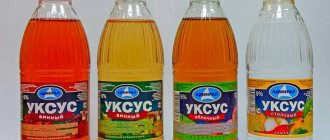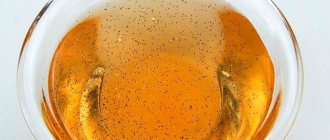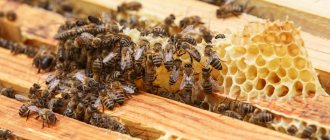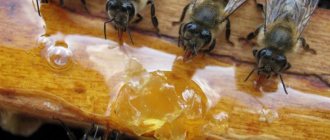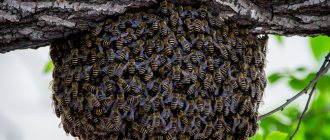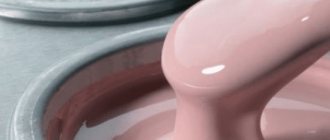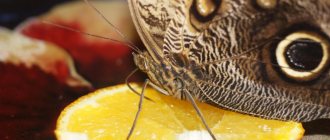- Blog articles
- Beekeeping
Beekeeping
Economics of beekeeping
Beekeeping news in Russia
Beekeeping news in the world
Honey
Propolis
Bee bread
Zabrus
Royal jelly
In the world about bees
Apiary
Bees
News from honey fairs
From the history of beekeeping
- What is Kandy?
- What are the benefits of kandi for bees?
- Cooking recipe
- Recipe "Classic"
- Sugar fudge recipe
- Kandy with flour
- Honey and milk powder
- What can you add to kandi?
- Feeding
- When is feeding needed?
- How to store a supply of Kandi for bees
What are the benefits of kandi for bees?
Most professional beekeepers choose a sugar-based composition for wintering bees. Along with beneficial substances, honey may also contain some types of pathogenic bacteria that can cause a deadly epidemic in the bee family. Attention! For preparation, you need only high-quality products: fresh honey from the last extraction and sweet confectionery powder without starch additives.
A sugar base is preferable to a honey base for the following reasons:
- bee colonies survive the winter period more successfully;
- individuals weakened during the winter quickly acquire an active form;
- shelf life is longer;
- promotes good digestion of bees, easier to digest than honey kandi;
- the composition is more economically beneficial.
The sweet, rich product acts in two ways: it is a good food, and a wonderful means of treatment, since it is most convenient to add it to candy for the prevention of diseases. The product can be bought, but it is better to prepare it at home, using proven ingredients.
Basic requirements for ingredients
At first glance, there is nothing complicated in making kandi - mix sugar with water, add honey, mix well and the dish is ready. In fact, not everything is so simple: it is necessary to strictly observe the given proportions and adhere to a certain sequence of actions. In addition, success largely depends on what ingredients are used in preparing the fertilizer. With the first necessary element - water - everything is simple. It is desirable that it be soft (in extreme cases, hard will do), but it must be clean and drinkable. As for the remaining components, each element needs to be considered separately.
Sugar
Sugar is an essential component of any type of kandi. Both beetroot and granulated cane sugar are suitable for preparing food.
Some recipes call for powdered sugar. You cannot use ready-made powder from stores - it contains starch, which is added to improve the friability of the product and prevent the formation of lumps. In addition, ready-made powdered sugar is not very finely ground. Coarse grinding (crystal size more than 0.2 mm) makes it difficult for bees to collect food; it hardens faster even after short-term storage. To be honest, the best solution would be to make your own powdered sugar. A small amount of the product can be obtained using a coffee grinder or blender with low-set blades. The powder obtained after grinding is sifted on a fine sieve, and the remaining larger crystals are ground again.
Sugar ground into powder using a coffee grinder
You should not overuse grinding granulated sugar in a coffee grinder, as this will negatively affect the condition of the device. Due to heating, sweet dust begins to melt and stick to the coffee grinder knives, increasing the load, which often leads to damage to the equipment.
If the apiary is large and requires appropriate volumes of raw materials, it is wiser to contact one of the catering establishments (for example, a bakery or confectionery shop), where they can grind the required amount of sugar into powder.
In the presented video, you can see how to make a convenient device for quickly producing powdered sugar at home from a simple grinder and a plastic bucket:
An important requirement in preparing high-quality kandi is inverting the sugar . In other words, before the insects receive food, the process of splitting sucrose molecules into glucose and fructose must occur. There are three ways to achieve this today:
- by acid hydrolysis - by adding citric or other organic acid to sugar syrup. This method has more disadvantages than advantages (its only advantage is the reaction speed). Only 40-50% of sucrose is inverted, the syrup is poor in mineral composition and, in addition, a substance harmful to insects is released - hydroxymethylfural, which negatively affects their life expectancy;
- using the natural enzyme invertase contained in honey. The initial components (74% granulated sugar, 7.5% flower honey, 18.5% water, 0.03% acetic acid) must be loaded into a container and kept for 7-10 days at a temperature of 34 to 36 ℃. The mixture must be stirred every day 2-3 times. Signs of completion of inversion are a decrease in the formation of foam (at the beginning of the process it is abundant) and complete dissolution of sugar, that is, the absence of its sediment at the bottom of the container;
- hydrolysis by adding special enzymes (fungal invertase). This method prevents the entry of harmful impurities and infections. The duration of the inversion ranges from 5 to 20 hours.
Honey
Sugar honey kandi uses flower honey, the most desired food for bees, as the second main ingredient. However, its use is fraught with danger. Poor quality honey or honey of unknown origin may contain pathogens that threaten to be fatal to the bee colony. Therefore, you need to use honey only from proven sources, from healthy insects, or it is better to abandon it altogether.
To prepare the top dressing, honey must be completely dissolved in a water bath.
During the dissolution process, you should never bring honey to a boil, otherwise all its beneficial properties will be lost.
Common Supplements
There are a large number of recipes for bee supplements, which contain a wide variety of additives. The presence of one or another component depends on the specific situation: for bee diseases - medications, for spring complementary feeding - a diet with a high protein content, winter feeding - vitamins and preventive measures:
| Types and purpose | Natural origin | Synthetic supplements/drugs |
| Treatment and prevention | Extracts of wormwood, eucalyptus globulus, pine needles, garlic, horsetail, purple coneflower, hot pepper | Nozemat, apitonus, aquafeed; nosemacid, mycoask, asconazole, fumagilin, etc. |
| Vitamin and protein | Bee bread, yeast, milk powder, soy, rye, wheat flour, egg powder | VESP, Polyzin, Stimovit, Polyamine, Univit, Biospon, Ovigid, Vita-Amin |
It is important to remember that all additives are added only at the end of the cooking process , otherwise the high temperature may change their chemical composition.
Cooking recipe
The base is prepared according to various recipes, choosing the most suitable one through numerous trials and possible errors. The honey base is thoroughly mixed for a long time before adding the ingredients. Sugar requires long-term boiling and simmering. Honey must be fresh, from the latest harvest. Powdered sugar must have a uniform consistency, without lumps or starch additives.
"Classic"
The recipe for kandi for bees is simple, the product is prepared quickly:
- Heat the honey base until it turns into a homogeneous mass so that lumps and crystals dissolve, but not higher than 60C.
- Cool the resulting hot mixture to 36-38C.
- Slowly add powdered sugar. When the base is sufficiently saturated with powder, it will no longer absorb the sweet sprinkles.
- Stir until smooth.
- Place on a board and knead like regular dough for about 0.5 hours.
- As soon as the batch loses its stickiness and becomes lumpy and hard to the touch, the product is ready.
Medicinal supplements
Whatever kandi recipe you choose, the base will always be the same - honey and sugar.
Then the beekeepers decide for themselves whether to prepare regular feeding or medicinal feeding. It depends on what you add to the honey dough.
As a result you can get:
- Regular kandi without additives. Just good feeding.
- Medicinal, with nosemate. I think you guessed by the name that this is a preventive remedy for nosematosis.
- With the addition of bee pollen - to restore carbohydrate and protein balance.
- With thymol (thyme) - for the treatment of nosematosis and various foulbroods. An excellent alternative to nosemate.
- To strengthen the immune system, add tinctures of mint or St. John's wort.
All supplements must be strictly dosed. Otherwise, any medicine turns into poison. Properly prepared feeding in compliance with all proportions specified in the recipe helps the rapid recovery of insects after wintering and prevents the appearance and spread of diseases in the apiary.
Helpful advice : if you decide to add medications to bee food, do it at the very end of preparation, since prolonged heating can cause a change in their properties.
Sugar fudge
To make fudge, you only need 3 ingredients: honey, powdered sugar, water. Clean water is poured into an enamel pan and heated. Upon reaching 60C, add sweet powder to hot water, boil for 20 minutes, stir thoroughly. The lumps need to be dissolved and the foam removed. The degree of readiness is checked by lowering the spoon first into the hot syrup, then immediately into cold water. A thickened, quickly separating mixture is an indicator of the readiness of the candy. If the composition turns out to be liquid, you need to continue boiling until ready. The finished product is boiled for another 3 minutes with 600 g of honey of unsolid consistency. If the sweet fudge is ready, cool it, stirring with a wooden spoon (a must!), the mass gradually lightens, acquiring the necessary density and viscosity.
Beneficial features
The product has certain advantages over other types of feeding:
- Strengthens the immunity of bees;
- Thanks to food, insects survive in the cold season;
- Feeding bees stimulates fertility;
- Mating, brood rearing and flight do not occur ahead of schedule.
- This type of food does not heat above 60 degrees. The feed does not contain burnt sugar, which causes bee diseases.
As a result, beekeepers get healthy colonies with good offspring in the spring.
Feeding
The feeding time is chosen according to the climate of the region. Experienced beekeepers advise calculating the laying approximately 2 weeks before the first flight, if the weather does not make adjustments. If the climate is warm and the bribe was carried out late, additional feeding will not be necessary.
Beginners and inexperienced beekeepers do not always correctly determine the need to add candy. You need to listen to the sounds from the hive: if a muffled rustling is heard from there near the wall, the food is running out, the bees are moving in search of food. You can carefully shine a flashlight with a red lamp into the hive (ordinary lighting irritates the family, especially if the bees are in a calm state).
Video: Winter feeding of Kandy bees
It is advisable to prepare Kandy right before storing it. The food is served in the following sequence:
- remove the cover;
- raise the insulating layer;
- lift the canvas.
Carefully distribute the sweet dough over the frame and close the bees, performing the same actions, but in reverse order. Another location is at the bottom of the hive, but this requires skill so that the winter hut does not open for a long time and the bees do not freeze. Experienced beekeepers always “treat” only the cooled mass - the warm cake instantly attracts striped eaters, they start eating ahead of time and destroy all the treats long before the end of wintering. This situation is extremely undesirable - experts almost unanimously do not recommend opening hives in winter, especially in unfavorable, harsh winter huts.
General tips and tricks
- Fertilizing in the winter hut should be carried out only at temperatures not lower than 2 degrees Celsius. This is the extreme bottom bar. At even lower temperatures, the bees simply will not take food.
- If feeding is difficult due to low temperature, it is necessary to move the selected families to an insulated room with a temperature of about 25 degrees. With such an increase in temperature, the bees quickly become more active and take food in full. In this case, the upper and lower tapholes must be temporarily opened during transfer. The transferred families keep their bags warm, after which they carry them back to the winter hut and bring the next family.
- From hunger, bees may freeze and show no signs of life. If only a couple of days have passed since then, they can be revived. To do this, you need to bring the family into a well-heated room, open the hive and sprinkle the liquid on the bees sitting and lying on the bottom. After this, you need to install a couple of honey frames in the hive and leave the bees alone. After just a few hours, the bees become more active, begin to buzz and eat food. After this, the hive can be transferred back to the winter hut and the entrance can be opened.
- Feeding bees with honey in winter must follow strict rules. Both in terms of preparation and in terms of serving. The wrong approach can cause the death of an entire family in a fairly short period of time.
- If you observe anxiety in one of the colonies, or all bees have digestive problems, it is recommended to temporarily place the entire hive in a heated room, check the condition of the food being used and, if possible, eliminate the source of the problem. Sometimes it becomes necessary to transplant the entire family into a new hive and move it back to the winter hive.
- Any work in winter associated with the opening of the hive always negatively affects the condition of the entire club. Therefore, they should only be carried out if absolutely necessary. If the temperature in winter huts drops below zero or the bees are kept free in the winter, they must be left alone until the weather warms up. They need peace.
Video: Feeding wintering bee colonies with honey and kandi
The sugary mass is wrapped in cellophane or mesh, preferably nylon, to protect against ticks or mosquitoes. Holes for access to nutritious sweetness can be made immediately, but insects can do this on their own, especially in thin materials. You cannot use gauze - the fabric is fibrous and quickly spreads. The inhabitants of the hive are frightened by such a covering; they may refuse complementary foods.
Video: Feeding bees honey kandi is the best choice
On a note! Many apiary owners prepare sugary syrup, but it can cause increased fertility and excessive activity of the bee colony. In this case, “demographic” problems will appear and a decrease in the performance of insects during the honey-bearing period. In winter, one family absorbs an average of 8 to 10-12 kg of honey, the amount depends on climatic conditions and the number of bees in the family. In former times, beekeepers left enough food in the hive to last until mid-summer. This advice is especially relevant for areas with harsh weather conditions, but in the last few years the climate has begun to change everywhere, so it is better not to feed in excess.
When to give
Fertilizing is carried out in winter and spring. In beekeeping, winter feeding with candy is performed only for three reasons:
- If there is a need to replace crystallized honey;
- Disease prevention;
- Little fodder was prepared in the fall
There is no point in feeding the bees one more time, because this creates additional stress on the intestines.
Feeding using candi in winter is carried out once a month. If the insects have not eaten the cake within this period, then you need to replace it with a new one and leave it for another month.
Feeding bees in early spring is the most important period in which to feed candy to bees. In March they begin to fly. During this period, bees feed once every two weeks. Spring feeding is different in that proteins are added to the feed. Flying workers need to be fed this type of food until June.

